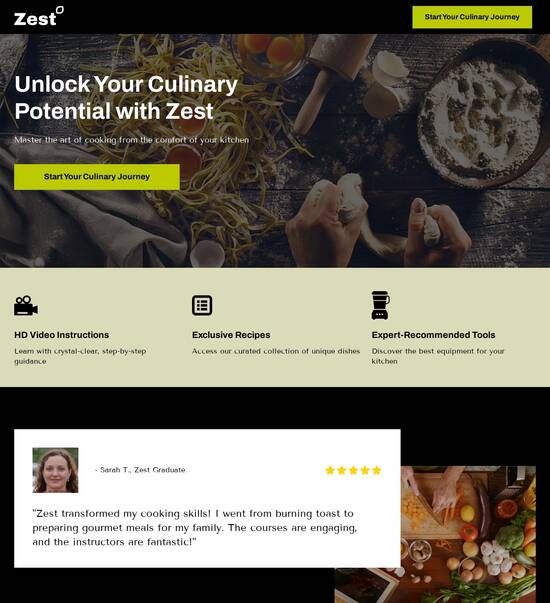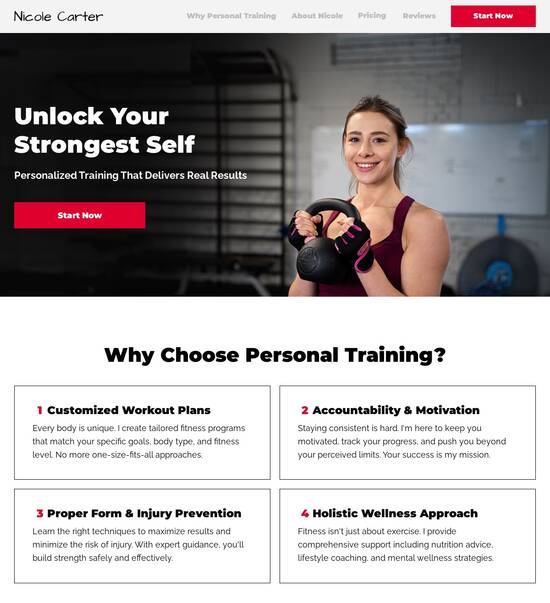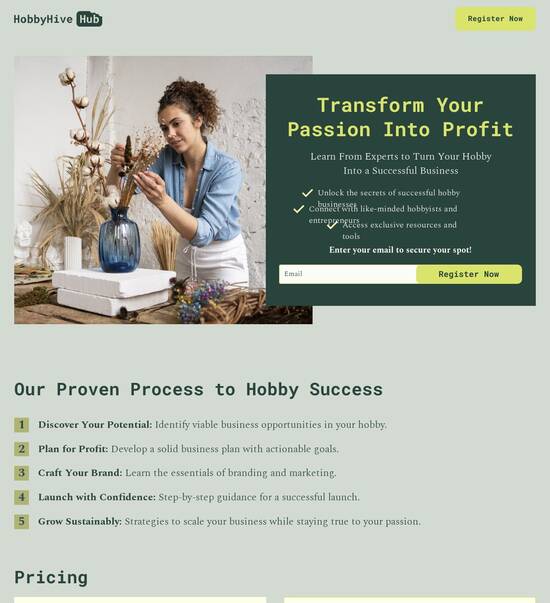
HTML/CSS optimized 404 error page template
Explore Similar TemplatesAbout template
Supercharge your 404 error page with HTML/CSS for outstanding performance! Learn more today.
Recommended templates

Easy to build without coding
With the intuitive drag-and-drop builder, anyone on your team can create high-converting pages without any knowledge of code or design. Make enhancements to your landing page with custom widgets using Javascript, HTML/CSS, or third-party scripts.

Multiple layouts for any industry and goal
Select from 500+ landing page layouts built to boost conversions across industry-specific scenarios. Customize them by adjusting fonts, adding images, and generating on-brand content with the AI assistant. Quickly scale with Instablocks® and Global Blocks that you can save, reuse, and update globally.

Loads fast and looks polished on any device
Every template is responsive, which means they present professionally on any device and load blazingly fast with our Thor Render Engine. You can also power them up with Google AMP technology to deliver an unparalleled mobile experience and drive higher conversions.

Robust analytics & experimentation
Get real-time updates and reporting across all your devices, showing the number of visitors, conversions, cost-per-visitor, and cost-per-lead. Launch AI-powered experiments, run A/B tests, and use heatmaps to analyze user behavior, then optimize your landing page to maximize conversions.







Easy to build without coding
With the intuitive drag-and-drop builder, anyone on your team can create high-converting pages without any knowledge of code or design. Make enhancements to your landing page with custom widgets using Javascript, HTML/CSS, or third-party scripts.
Multiple layouts for any industry and goal
Select from 500+ landing page layouts built to boost conversions across industry-specific scenarios. Customize them by adjusting fonts, adding images, and generating on-brand content with the AI assistant. Quickly scale with Instablocks® and Global Blocks that you can save, reuse, and update globally.
Loads fast and looks polished on any device
Every template is responsive, which means they present professionally on any device and load blazingly fast with our Thor Render Engine.
Robust analytics & experimentation
Get real-time updates and reporting across all your devices, showing the number of visitors, conversions, cost-per-visitor, and cost-per-lead. Launch AI-powered experiments, run A/B tests, and use heatmaps to analyze user behavior, then optimize your landing page to maximize conversions.
All the features you need to build 404 page template
Explore more featuresLearn how to build 404 template
Frequently asked questions about 404 template html
Leading the way in building high-performing landing pages





404 page template html css: Your ultimate how-to guide
Instapage stands out as a powerful solution for marketers seeking to enhance their digital campaigns. With its intuitive design, high-converting templates, and robust collaboration tools, Instapage is tailored to meet the needs of marketing professionals across various sectors in the USA.
Understanding Instapage and its advantages
Instapage offers a plethora of features that go beyond standard landing page creation. It empowers users with capabilities to optimize their campaigns, track performance, and collaborate seamlessly. Here's why it's indispensable for modern marketing:
- High-converting templates: Choose from over 100 professionally designed templates that are optimized for lead generation, ensuring quick setup and immediate impact.
- Built-in optimization tools: Utilize A/B testing and heat mapping to refine your pages for maximum conversion rates, allowing for data-driven improvements.
- Personalization features: Engage different audience segments with tailored content experiences that resonate with unique visitor demographics.
Step 1: Setting up your landing page
Creating a striking landing page on Instapage is straightforward. Start by selecting a template from the extensive library that aligns with your campaign goals. Once chosen, use the intuitive drag-and-drop builder to customize your content:
- Add your branding: Incorporate logos, brand colors, and any relevant imagery to ensure consistency with your overall marketing strategy.
- Incorporate forms: Use pre-built lead capture forms to collect information from visitors effortlessly.
- Utilize Instablocks: Leverage modular content blocks for easy arrangement; these can be customized and reused across multiple pages.
Step 2: Optimize for performance
Post-creation, the focus shifts to optimization. Instapage's built-in tools allow you to analyze user interaction and make informed modifications to enhance turnout:
- Heatmaps: Gain insights into how users navigate your page, identifying areas of interest and potential distractions that may need adjustment.
- A/B testing: Experiment with variations in content, design, and layout to discover which approach yields the highest conversion rates.
- Analytics dashboard: Track performance metrics that matter — conversions, bounce rates, and click-through rates can help guide future tactics.
Step 3: Personalization to boost engagement
Leveraging Instapage's dynamic content features can elevate the visitor experience significantly. Adapt messages based on the user's demographics or previous interactions with your brand:
- Dynamic text replacement: Automatically adjust text on the landing page based on the ad that brought the visitor to it, making the experience more coherent.
- Audience segmentation: Tailor content based on user segments to address specific needs and capture higher engagement.
- AdMaps: Align specific advertisements with tailored landing pages to ensure a seamless transition from advertisement to landing experience.
In conclusion, using Instapage optimally requires understanding its varied tools and applications. When harnessed effectively, marketing teams can maximize their campaign effectiveness and ROI.
Ready to transform your marketing strategy? Explore Instapage to begin crafting high-converting landing pages that resonate with your audience!
People also ask about HTML/CSS optimized 404 error page template
Creating an html/css optimized 404 error page template
Understanding the significance of an optimized 404 error page
A 404 error page serves an important function in the overall user experience of a website. While it may indicate that a user has landed on a page that does not exist, how a brand handles this scenario can either frustrate or soothe users. An optimized 404 page transforms a moment of confusion into an opportunity for understanding and redirection. Instead of simply stating 'Page Not Found,' effective pages offer a clear path forward, maintaining the trust and interest of frustrated users.
The significance of brand voice is especially crucial in these moments. A consistent tone can provide reassurance and enhance user engagement even when things go awry. By incorporating elements that resonate with the brand's personality, companies can effectively mitigate frustration and establish a connection with the user.
Common user queries and expectations upon encountering a 404 error
When users stumble upon a 404 page, they typically have a few common queries. The most prominent ones revolve around 'What happened?' and 'Where do I go from here?' An optimized 404 page can clarify these points by providing insightful content and navigational options. Clear messaging can help to dispel any misconceptions, guiding users back to relevant content instead of leaving them stranded.
Users expect several things when they land on a 404 page. They want informative and reassuring messaging, suggestions for alternate content, and quick access to navigation features they can understand. By addressing these expectations, brands can turn a negative experience into a manageable one, by retaining users instead of losing them.
Essential elements of an html/css optimized 404 error page template
An effective 404 error page contains several core components. First and foremost, the messaging must be clear concerning the error. It should include a friendly apology, detailed information about what might have occurred, and a path toward alternative content. This reaffirms the brand's commitment to user satisfaction, even in times of disappointment.
Brand and visual consistency are also key. The design elements should echo the site's overall aesthetic to establish trust with visitors. Familiar colors, logos, and typography can alleviate the shock of an error, allowing users to feel more at ease.
Additionally, navigational prompts lead to relevant content, providing users with options instead of leaving them confused. Suggesting popular pages, a search bar, or even links to the homepage can significantly enhance the user experience.
Innovative technologies behind effective 404 pages
Utilizing innovative technologies can further enhance the effectiveness of a 404 page. For instance, employing CSS media queries allows for a mobile-responsive design, ensuring that the page adjusts seamlessly to various screen sizes which is vital in today's multi-device landscape.
Another important technology is JavaScript, which can introduce various dynamic features. You might consider an interactive element that asks users what they're looking for, offering automated suggestions directed to the right content. Additionally, accessibility technologies are crucial. Ensuring that the page meets WCAG guidelines enables inclusivity for all users, regardless of any disabilities they may have.
Crafting the ultimate html/css template for a 404 page
Creating an optimized 404 error page begins with setting up a well-structured HTML template. By utilizing semantic markup and keeping the code clean and understandable, developers can not only improve SEO but also enhance the maintenance of the page in the long run. For instance, using appropriate heading tags and clearly annotating code can facilitate easier updates in the future.
Next, styling the page with CSS allows you to evoke specific emotions through color theory and typography. Utilizing contrasting colors can draw attention to key elements whilst maintaining an overall pleasing aesthetic. Moreover, best practices for typography and spacing ensure that the text is legible, making it easy for users to read and navigate.
After establishing the basic structure, incorporating interactive elements with JavaScript can significantly elevate user engagement. Adding features like animations can help reduce perceived wait times and create a visually appealing experience that eases the frustration of landing on a 404 page.
Optimization techniques for enhanced performance
Performance optimization is essential for an effective 404 page. Minifying CSS and HTML can lead to quicker loading times, which is vital for retaining users who may otherwise leave due to slow responses. Employing lazy loading techniques for images and other media assets ensures that they are only downloaded as users scroll, further enhancing the speed of your webpage.
Finally, conducting regular testing and personalization can refine the experience for users. Monitoring how frequent users encounter the 404 page and tweaking content based on analytics can offer insights into underlying issues, further providing an improved experience.
Real-world applications and examples of effective 404 pages
Analyzing successful implementations of 404 pages can yield invaluable lessons. Brands like Netflix and Airbnb have turned their error pages into opportunities for user engagement. For example, Airbnb uses whimsical graphics and phrasing that lightens the experience while still guiding users effectively to relevant content. By presenting a humorous twist, they mitigate the frustration typically associated with a 404 error.
Such creative approaches reduce bounce rates significantly while capturing users' attention. In looking at these examples, one can gather insights into how engaging elements like personalized messages or playful visuals keep users invested in the brand rather than abandoning it outright.
QA community insights on 404 user experience
User research studies reveal surprising insights regarding user experience with 404 pages. Feedback often highlights that users appreciate effective messaging more than they do creative designs. Clarity and a sense of direction seem to resonate strongly, suggesting that a straightforward approach is often better than an overly elaborate one.
Furthermore, understanding the common user journeys post-encounter can guide brands. Many users appreciate alternative links prominently displayed, as well as search functionality that directs them to relevant content, which exacerbates the need for careful thought in crafting an effective error resolution strategy.
The path to community collaboration in design and coding
Leveraging community resources can enhance the design and coding process for error pages. Many coding forums and collectives provide valuable insights and tips that can inspire fresh ideas or inform decisions through shared experiences. Websites like GitHub and Dribbble exemplify spaces where one can seek inspiration or even collaborate on projects with fellow developers and designers.
Diverse perspectives allow for a fuller understanding of common pitfalls and best practices, facilitating the growth of skills in both design and coding. Sharing feedback through community platforms can lead to improved methodologies while fostering a culture of collaboration among professionals.
Accessing available tools for 404 page coding
When coding a 404 error page, several tools and frameworks can simplify the process. Utilizing platforms like Bootstrap can expedite responsive designs, while code validation tools ensure that your markup is clean, preventing common errors. Development environments such as Visual Studio Code are indispensable for streamlining coding practices, offering features like linting and syntax highlighting which assist in the coding process.
Furthermore, open-source templates can serve as excellent springboards for creativity, providing pre-built structures that can easily be customized. These templates facilitate learning from others' successes and failures, ultimately enhancing the design's overall effectiveness through community-generated ideas.
The impact of location and team dynamics on 404 page design
User experience with error pages can be heavily influenced by cultural contexts. Different communities often have unique expectations when it comes to user error messaging. For instance, in some cultures, direct communication is valued, while others may prefer a more whimsical or lighthearted approach. Understanding these cultural nuances can guide the tone and messaging of a 404 page, leading to a more tailored user experience.
Additionally, the internal dynamics of the team working on the design can play a significant role. Interdisciplinary collaboration among designers, developers, and content creators can yield better results. Organizing effective brainstorming sessions can facilitate cross-functional insights, enabling creativity and innovation that might not occur in siloed workflows.
Addressing fundamental questions about 404 error pages
Several misconceptions surround 404 error pages. Notably, many assume that all 404 pages must look uniform or adhere to a specific structure. The truth is that they can vary greatly, tailoring to the unique voice and identity of a brand. Customization is vital in this field, allowing companies to communicate with their users effectively and reflect their personalities.
Evaluating the effectiveness of a 404 page should involve various tools for tracking user behavior. Heatmaps, session recordings, and user feedback surveys can offer insights for measuring success and identifying areas for improvement. Regular assessment based on this data can inform necessary adjustments to ensure continued effectiveness.
Looking ahead: Evolving practices in error page design
The landscape of error page design continues to evolve, particularly with the advent of emerging technologies. As artificial intelligence (AI) becomes more integrated into web design, anticipating trends that enhance user personalization will be critical. Tailoring 404 pages to individual user preferences, possibly utilizing data gathered from previous interactions, could enrich the experience significantly.
Moreover, nurturing a culture of continuous learning within design teams is crucial. Opportunities for workshops, training sessions, and knowledge-sharing forums should be a prominent feature of team dynamics. Encouraging feedback loops will facilitate iterative design improvements, ensuring that the 404 page remains current and effective well into the future.
Ready to skyrocket conversions?
Supercharge your ad campaigns with high-performing landing pages
Get started














